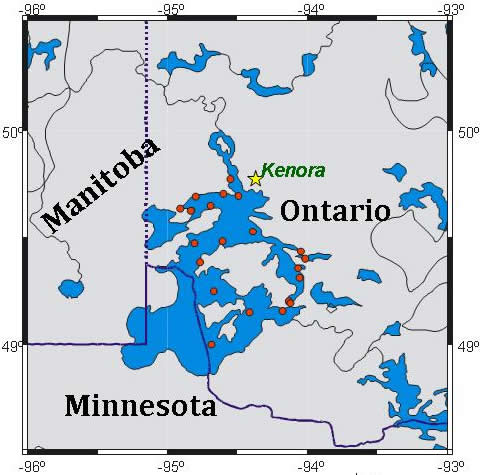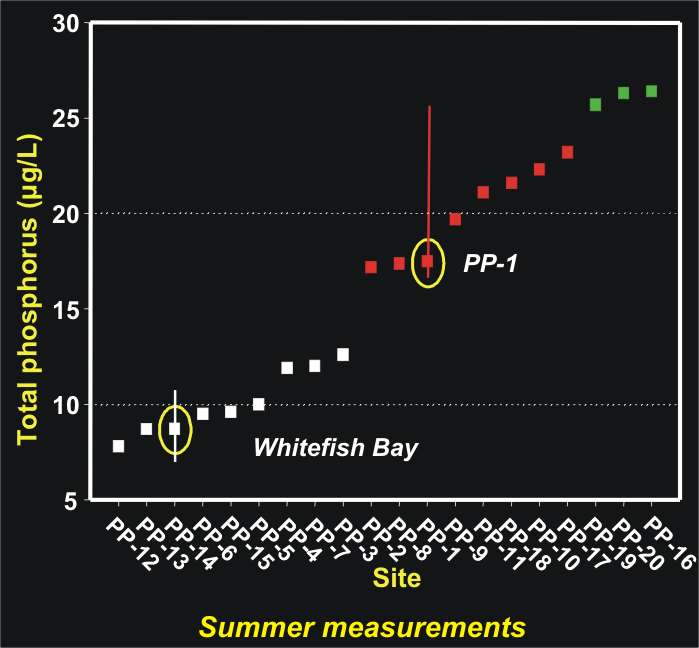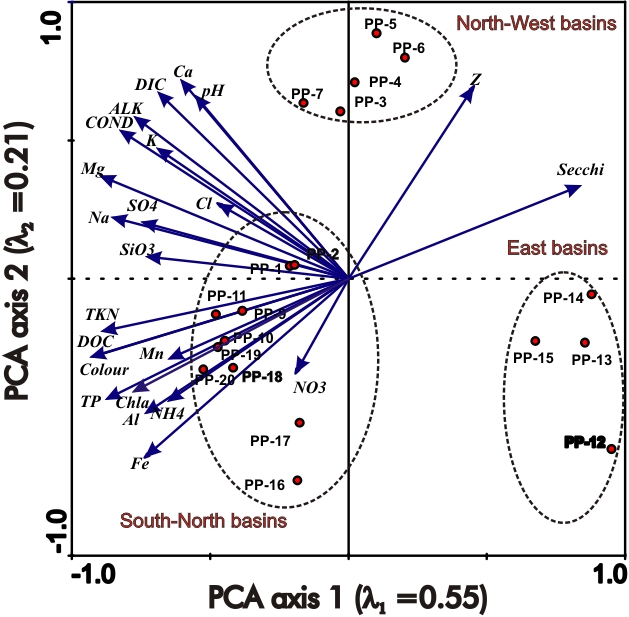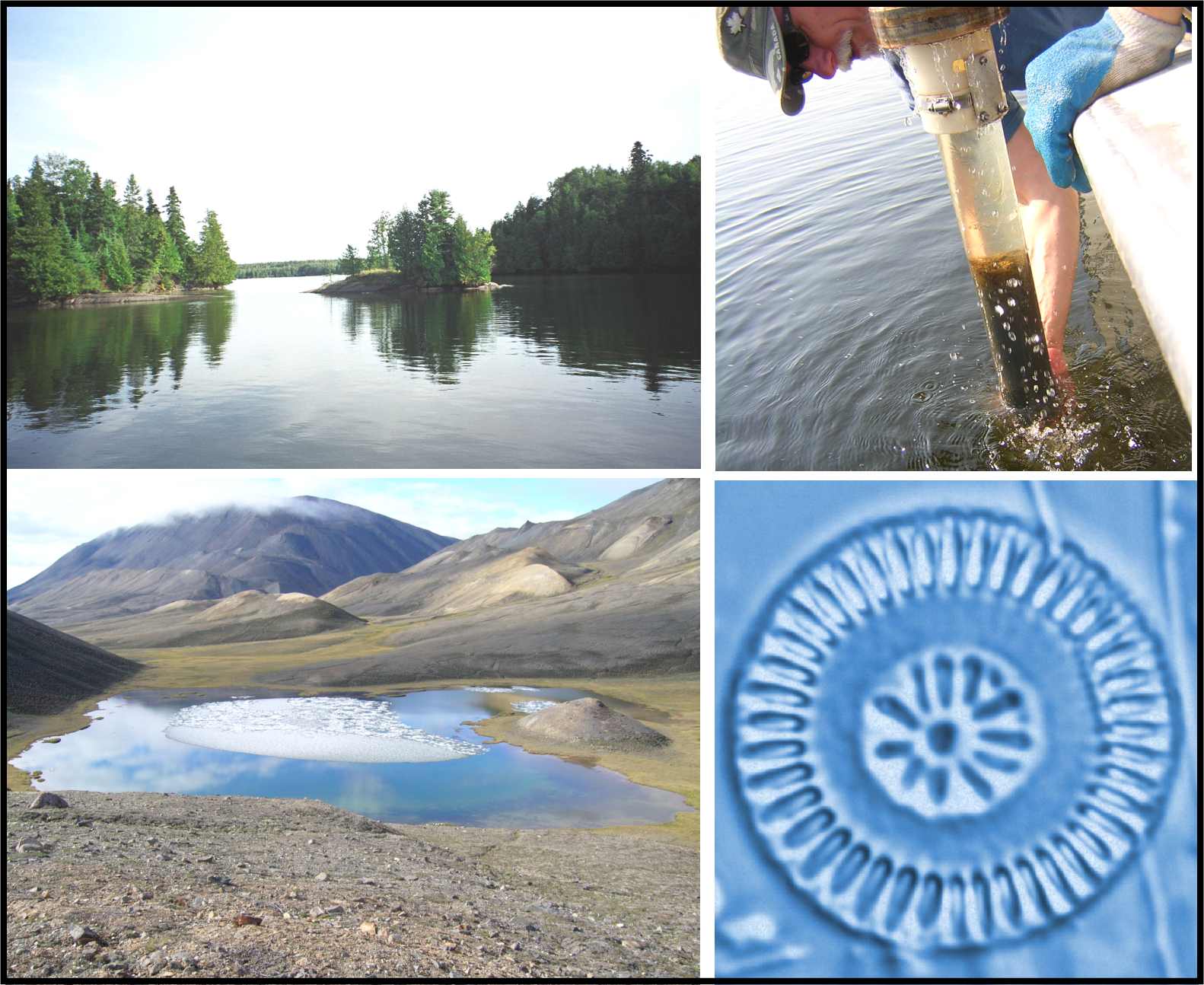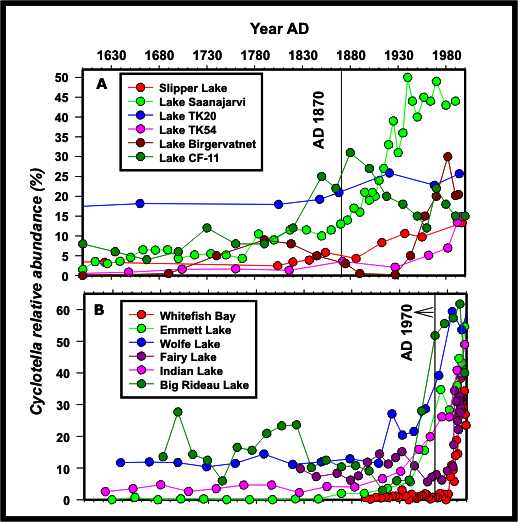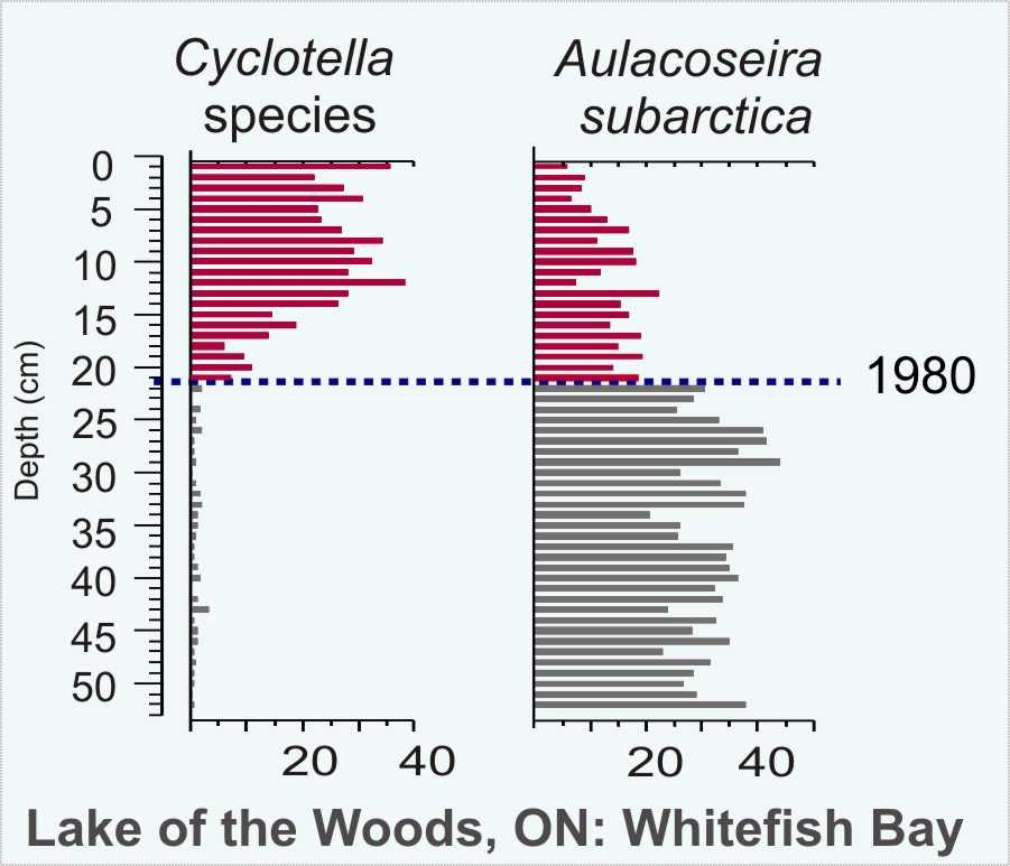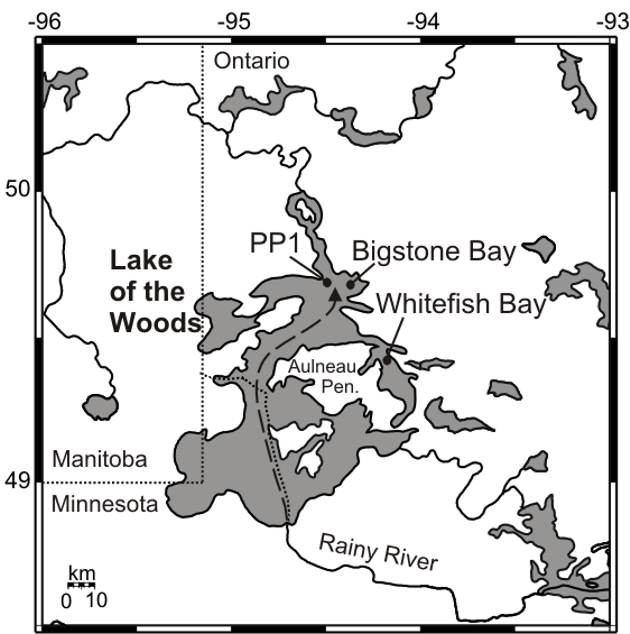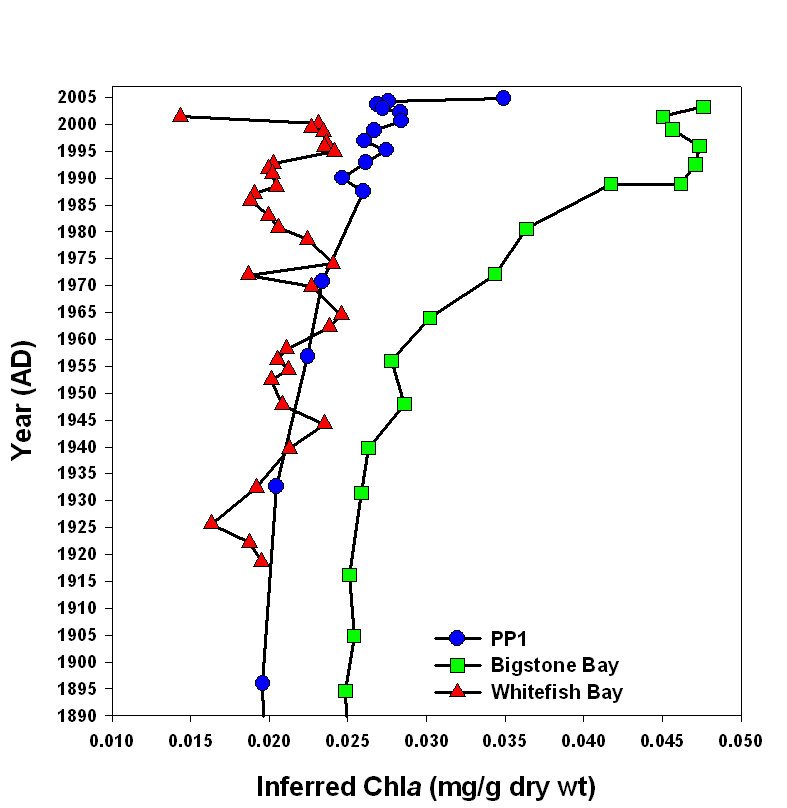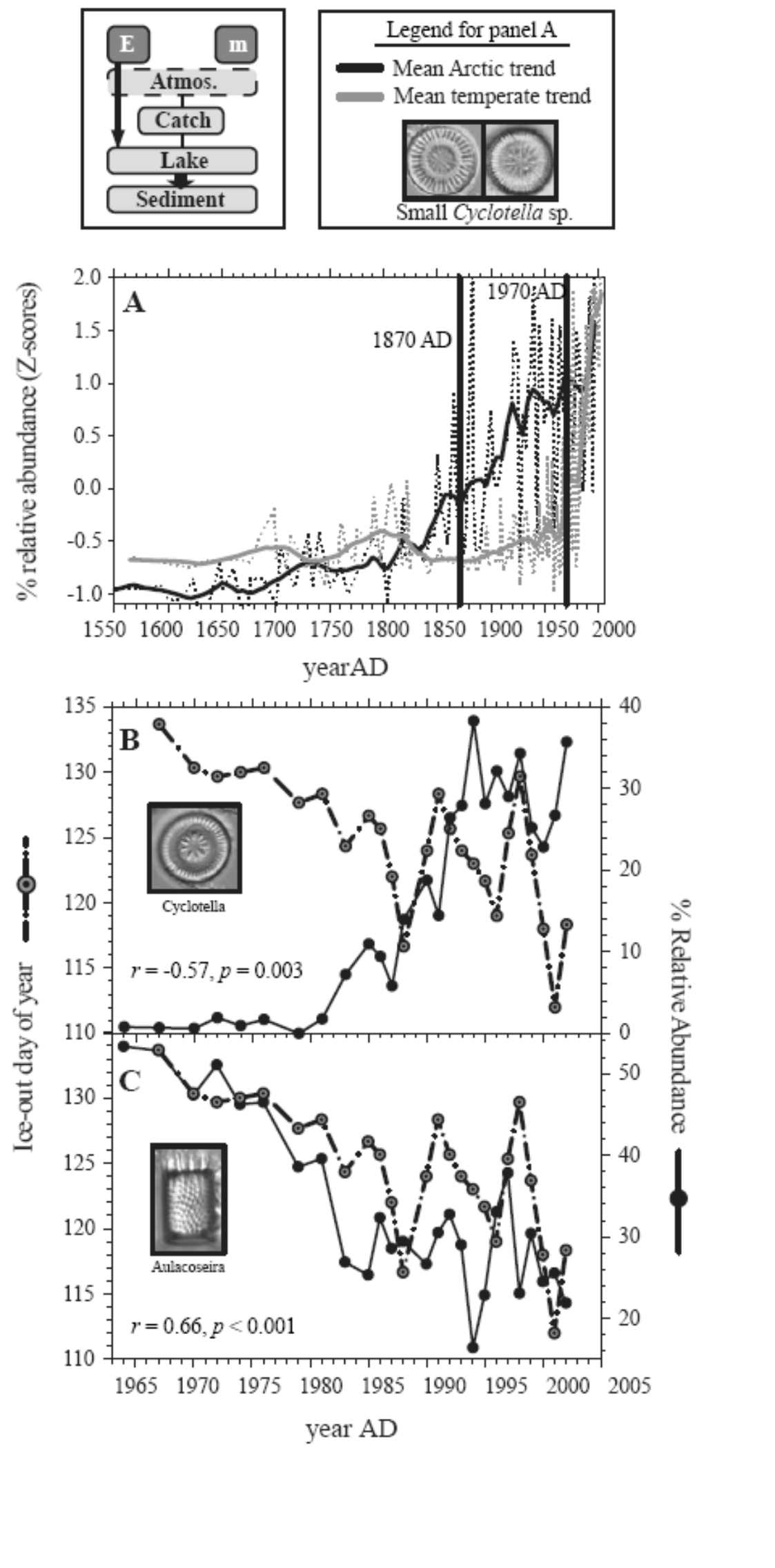
| |
| HOME |
| PEOPLE |
| RESEARCH |
| PRESENTATIONS |
| NEWS & LINKS |
| P.E.A.R.L. |
| Peer-Reviewed Publications on the LoW from PEARL |
||
|
||
| 1) Pla, S., Paterson, A.M., Smol J.P., Clark, B.J., and Ingram, R. 2005. Spatial variability in water quality and surface sediment diatom assemblages in a complex lake basin: Lake of the Woods, Ontario, Canada. Journal of Great Lakes Research 31: 253-266. |
||
ABSTRACT Lake of the Woods (LOW) is an international waterbody spanning the Canadian provinces of Ontario and Manitoba, and the U.S. state of Minnesota. In recent years, there has been a perception that water quality has deteriorated in northern regions of the lake, with an increase in the frequency and intensity of toxin-producing cyanobacterial blooms. However, given the lack of long-term data these trends are difficult to verify. As a first step, we examine spatial and seasonal patterns in water quality in this highly complex lake on the Canadian Shield. Further, we examine surface sediment diatom assemblages across multiple sites to determine if they track within-lake differences in environmental conditions. Our results show that there are significant spatial patterns in water quality in LOW. Principal Component Analysis divides the lake into three geographic zones based primarily on algal nutrients (i.e., total phosphorus, TP), with the highest concentrations at sites proximal to Rainy River. This variation is closely tracked by sedimentary diatom assemblages, with [TP] explaining 43% of the variation in diatom assemblages across sites. The close correlation between water quality and the surface sediment diatom record indicate that paleoecological models could be used to provide data on the relative importance of natural and anthropogenic sources of nutrients to the lake. INDEX WORDS: Water quality, diatoms, total phosphorus, spatial patterns, Lake of the Woods
|
||
| 2) Rühland, K., Paterson, A.M., and Smol, J.P. 2008. Hemispheric-scale patterns of climate-related shifts in planktonic diatoms from North American and European lakes. Global Change Biology 14: 2740-2754. | ||
ABSTRACT A synthesis of over 200 diatom-based paleolimnological records from nonacidified/nonenriched lakes reveals remarkably similar taxon-specific shifts across the Northern Hemisphere since the 19th century. Our data indicate that these diatom shifts occurred in conjunction with changes in freshwater habitat structure and quality, which, in turn, we link to hemispheric warming trends. Significant increases in the relative abundances of planktonic Cyclotella taxa (P<0.01) were concurrent with sharp declines in both heavily silicified Aulacoseira taxa (P<0.01) and benthic Fragilaria taxa (P<0.01). We demonstrate that this trend is not limited to Arctic and alpine environments, but that lakes at temperate latitudes are now showing similar ecological changes. As expected, the onset of biological responses to warming occurred significantly earlier (P<0.05) in climatically sensitive Arctic regions (median age=A.D. 1870) compared with temperate regions (median age=A.D. 1970). In a detailed paleolimnological case study, we report strong relationships (P<0.005) between sedimentary diatom data from Whitefish Bay, Lake of the Woods (Ontario, Canada), and long-term changes in air temperature and ice-out records. Other potential environmental factors, such as atmospheric nitrogen deposition, could not explain our observations. These data provide clear evidence that unparalleled warming over the last few decades resulted in substantial increases in the length of the ice-free period that, similar to 19th century changes in high-latitude lakes, likely triggered a reorganization of diatom community composition. We show that many nonacidified, nutrient-poor, freshwater ecosystems throughout the Northern Hemisphere have crossed important climatically induced ecological thresholds. These findings are worrisome, as the ecological changes that we report at both mid- and high-latitude sites have occurred with increases in mean annual air temperature that are less than half of what is projected for these regions over the next half century. KEYWORDS: climate, Cyclotella, ice-out, meta-analysis, Northern Hemisphere lakes, paleolimnology, planktonic diatoms [PDF]
|
||
| 3) Michelutti, N., Blais, J.N., Cumming, B.F., Paterson, A.M., Rühland, K., Wolfe, A.P., and Smol, J.P. 2009. Do spectrally-inferred determinations of chlorophyll a reflect trends in lake trophic status? Journal of Paleolimnology DOI 10.1007/s10933-009-9325-8. | ||
ABSTRACT Visible reflectance spectroscopy (VRS) has been used to reconstruct lake sediment chlorophyll a concentrations. Despite good concordance between inferred and measured chlorophyll a values, questions remain as to whether this spectral technique is faithfully tracking past changes in aquatic primary production, or simply recording a diagenetic signal. In this study, we critically evaluate how well VRS chlorophyll a determinations track past aquatic primary production using sediment cores from several lake systems with well-known trophic histories. Our study sites include Arctic, boreal and prairie lakes that encompass a gradient of trophic states. In general, our spectrally-inferred chlorophyll a values tracked past changes in lake trophic status consistent with historical measurements of production, or as inferred by independent proxies of primary production. We conclude that VRS chlorophyll a inferences indeed track histories of lake production and that this method is widely applicable as a rapid, inexpensive and non-destructive alternative to wet-chemical analyses of sediment chlorophyll a concentrations.
|
||
|
4) Leavitt, P.R., Fritz, S.C., Anderson, N.J., Baker, P.A., Blenckner, T., Bunting, L., Catalan, J., Conley, D.J., Hobbs, W.O., Jeppesen, E., Korhola, A., McGowan, S., Rühland, K., Rusak, J.A., Simpson, G.L., Solovieva, N., and Werne, J. 2009. Paleolimnological evidence of the effects on lakes of energy and mass transfer from climate and humans. Limnology and Oceanography 54: 2330-2348. |
|
ABSTRACT The premise of this review is that climate effects on lakes can be quantified most effectively by the integration of process-oriented limnological studies with paleolimnological research, particularly when both disciplines operate within a common conceptual framework. To this end, the energy (E) – mass (m) flux framework (Em flux) is developed and applied to selected retrospective studies to demonstrate that climate variability regulates lake structure and function over diverse temporal and spatial scales through four main pathways: rapid direct transfer of E to the lake surface by irradiance, heat, and wind; slow indirect effects of E via changes in terrestrial development and subsequent m subsidies to lakes; direct influx of m as precipitation, particles, and solutes from the atmosphere, and; indirect influx of water, suspended particles, and dissolved substances from the catchment. Sedimentary analyses are used to illustrate the unique effects of each pathway on lakes, but suggest that interactions among mechanisms are complex and depend on the landscape position of lakes, catchment characteristics, the range of temporal variation of individual pathways, ontogenetic changes in lake basins, and the selective effects of humans on m transfers. In particular, preliminary synthesis suggests that m influx can overwhelm the direct effects of E transfer to lakes, especially when anthropogenic activities alter m subsidies from catchments.
|
||
|
5)
Rühland, K., Paterson, A.M., Hargan, K., Jenkin, A., Clark, B., and
Smol, J.P. 2010. Reorganization of algal communities in the Lake of
the Woods (Ontario, Canada) in response to turn of the century
damming and recent warming. Limnology and Oceanography 55: 2433-2451 |
|
ABSTRACT Paleolimnological approaches were used to assess the ecological and environmental implications of diatom assemblage compositional changes recorded over the last ca. 200 years from four sites in the Lake of the Woods (LoW), Ontario, Canada. Comparisons between a reference site (Whitefish Bay) and three disturbed sites (Bigstone Bay, Paleolimnological Project site #1 (PP-1), and Forrest Island) provide insights into the effects that multiple stressors (dam construction, total phosphorus (TP) changes, and recent warming) have had on the ecology of this highly complex freshwater system. Overall patterns of diatom compositional changes from high-resolution 210Pb-dated sediment cores revealed a strong temporal coherence ca. 1910 and then again over the last few decades among all sites. Hydromanagement activities at the turn of the 19th century and recent warming over the last few decades played key roles in the LoW diatom changes. Diatom compositional changes at all sites were significantly related to trends in nearby air temperature records and to changes in lake ice phenology over the past ca. 40 years from Whitefish Bay. Turn-of-the-century hydromanagement activities do not appear to have had long-term effects on diatom-inferred total phosphorus (DI-TP), particularly at the disturbed sites. Clear decreases in DI-TP over the last few decades were evident at all sites, but at the reference site were well below pre-disturbance levels, which we link in part to recent warming. Substantial changes in climate will amplify the effects of multiple stressors on lakewater properties that have major implications on algal communities.
|
|
6) Hyatt, C.V., Paterson, A.P.,
Rühland, K.M., Smol, J.P. 2011. Examining 20th century
water quality and ecological changes in the Lake of the Woods,
Ontario, Canada: A paleolimnological investigation. Journal of
Great Lakes Research 37:456-459. |
ABSTRACT Comparisons between diatom assemblages preserved in modern and pre-industrial sediments were made to provide a lake-wide paleolimnological assessment of environmental change in 17 sites located throughout the Ontario portion of the Lake of the Woods (LoW). Diatom changes were consistent across all sites, although the magnitude of these changes varied along a trophic gradient (i.e., main channel sites versus isolated bays). The most notable taxonomic shift was towards a higher relative abundance of small, centric Cyclotella taxa and other planktonic, pennate diatoms (e.g., Asterionella formosa, Fragilaria crotonensis) in the modern sediments, with corresponding lower relative abundances of heavily silicified Aulacoseira taxa and small benthic Fragilaria taxa. To aid in determining whether changes in nutrients can explain the diatom trends, weighted averaging partial-least-squares (WA-PLS) techniques were used to develop a diatom-based inference model to reconstruct changes in total phosphorus (TP) concentrations. Diatom-inferrred TP (DI-TP) reconstructions revealed that 88% of the sites showed either no change or a slight, but not significant decline in DI-TP since pre-industrial times. Diatom-based inferences suggest that TP concentrations at many sites in the Ontario portion of the LoW were moderately elevated in nutrients prior to any major human disturbances (i.e., pre-1850). Results suggest that substantial increases in temperature over the last few decades, and the associated changes to ice cover and water column properties, have likely exacerbated the effects of existing stressors on the system and were key factors influencing a lake-wide restructuring of the diatom communities over the past ca. 150 years. |
|
7) Summers, J.C., Rühland, K.M., Kurek,
J., Quinlan, R., Paterson, A.P., and Smol, J.P. 2012. Multiple
stressor effects on water quality in Poplar Bay, Lake of the Woods,
Canada: a midge-based assessment of hypolimnetic oxygen conditions
over the last two centuries. Journal of Limnology 71: 34-44. |
ABSTRACT Chironomid and Chaoborus (midge) remains preserved in a dated sediment core from Poplar Bay, Lake of the Woods (LOW), Ontario, Canada, were used to assess the effects of multiple stressors (e.g., recent warming and shoreline development) on water quality over the past ~200 years. As monitoring data for LOW do not extend beyond recent decades, paleolimnological methods are used to reconstruct long-term limnological trends and to establish pre-disturbance conditions. The effects of recent warming and shoreline development on Poplar Bay water quality are examined using an index of hypolimnetic oxygen (O2) status based on the ratio of Chaoborus to chironomid remains (chaob:chir) and a midge-inferred volume-weighted hypolimnetic oxygen (VWHO) model. Our paleolimnological data indicate that hypolimnetic [O2] in Poplar Bay have been historically hypoxic (1-4 mg O2 L-1) but have declined further (generally <2 mg O2 L-1) over the last few decades. Significant relationships between air temperature and midge data indicate that substantial warming starting in the late-1970s has triggered a marked response in the midge assemblages that pre-dates the onset of cottage development (mid-1990s). These findings complement a diatom-based study on the same sediment core, likewise suggesting that recent warming has played a prominent role in structuring limnetic communities. However, it is likely that the full, compounded effects of recent warming and shoreline development have not yet been realized. Our study highlights the complexity of multiple stressor systems, such as Poplar Bay, and emphasizes the benefits of using multiple, independent lines of paleoenvironmental evidence in gaining a more complete understanding of historical water quality. | ||
Other Paleolimnological Publications of Interest |
||
Ramstack, J.M., Fritz, S.C., Engstrom, D.R., and Heiskary, S.A. 2003. The application of a diatom-based transfer function to evaluate regional
water-quality trends in Minnesota since 1970. Journal of Paleolimnology 29: 79–94. |
||
Ramstack, J.M., Fritz, S.C., and Engstrom, D.R. 2004. Twentieth century water quality trends in
Minnesota lakes compared with presettlement
variability. Canadian Journal of Fisheries and Aquatic Sciences 61: 561–576. |
||
Yang, Z., and Teller, J.T. 2005. Modeling the history of Lake of the Woods since 11,000 cal yr B.P. using GIS. Journal of Paleolimnology 33: 483–498. |
||
Reavie, E. and Baratono, N.G. 2007. Multi-core investigation of a lotic bay of Lake of the Woods
(Minnesota, USA) impacted by cultural development. Journal of Paleolimnology 38:137–156. |
||
Suchy, K.D., and Hann, B.J. 2007. Using microfossil remains in sediments to examine the invasion of Eubosmina coregoni (Cladocera, Bosminidae) in Lake of the Woods, Ontario, Canada. Journal of Great Lakes Research 33: 867-874. |
||
Heiskary, S. and Wilson, B. 2008. Minnesota’s approach to lake
nutrient criteria development. Lake and Reservoir Management 24: 282-297. |
||
Serieyssol, C.A., Edlund, M.B. and Kallemeyn, L.W. 2009. Impacts of settlement, damming, and hydromanagement in two boreal lakes: a comparative paleolimnological study. Journal of Paleolimnology DOI 10.1007/s10933-008-9300-9. |
||
|
Non-refereed publications & theses |
||
| Hargan, K. 2008. Recent environmental changes in a nutrient-enriched site in the Lake of the Woods, Ontario, Canada: a diatom-based paleolimnological investigation. BSc Honours Thesis, Queen's University, Ontario, Canada, 50pp. | ||
| Jenkin, A. 2009. Diatom-based paleolimnological assessment of long-term water quality trends near Forrest Island, Lake of the Woods, Ontario. BSc Honours Thesis, Queen's University, Ontario, Canada, 60pp. | ||
|
Rentz, K. 2015. Diatom assemblage trends in Lake of the Woods, Ontario, throughout the Holocene. BSc Honours Thesis, Queen’s University, Ontario, Canada, 35 pp.
|
||
